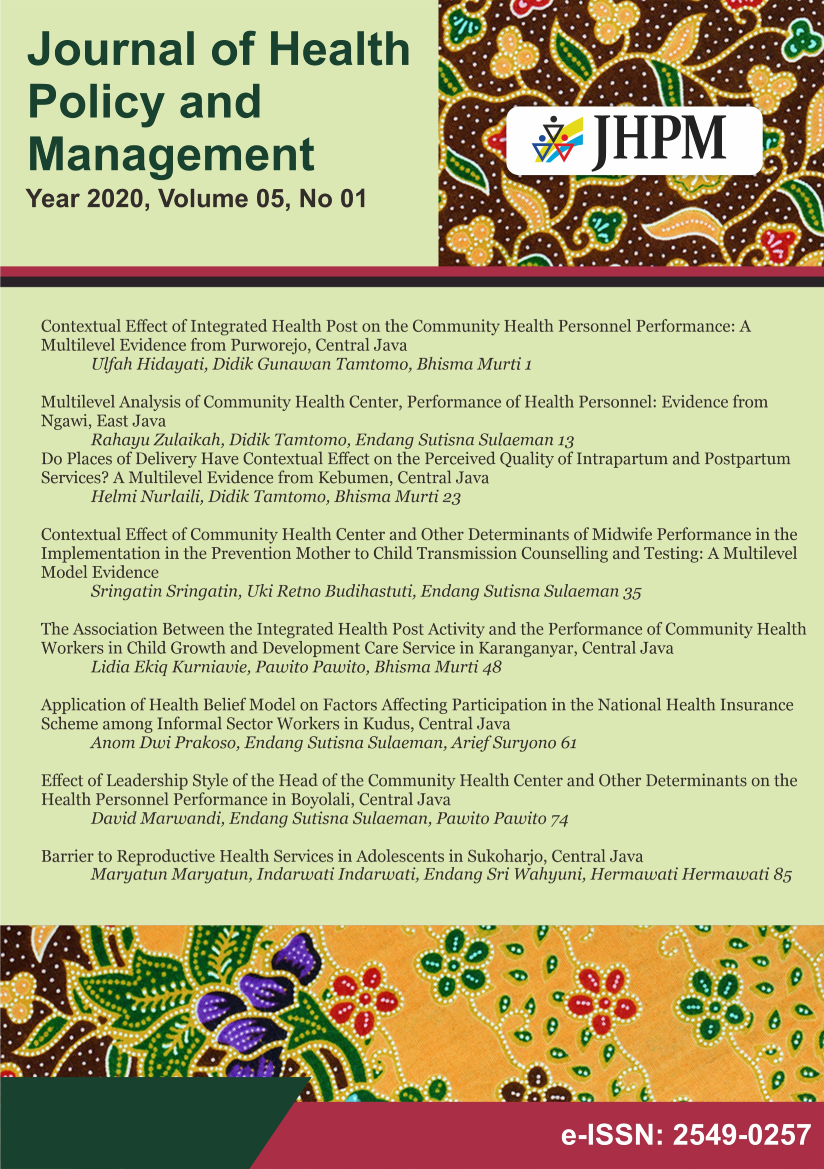Barrier to Reproductive Health Services in Adolescents in Sukoharjo, Central Java
Abstract
Background: Adolescent reproductive health information and services (KRR) are right, teenagers are helped to recognize themselves and matters relating to reproductive health. By having correct information, adolescents can equip themselves with behaviors and skills that can protect themselves from various reproductive health risks. This study aimed to analyze the factors that influence barriers to adolescent reproductive health services in schools.
Subjects and Method: This was a cross sectional study was conducted at high schools in Sukoharjo, Central Java, from April to May 2018. The sample was 281 students selected by purposive sampling. The dependent variable is barriers to adolescent reproductive health services. The independent variables are attitude, information, distance of service, ability of service personnel, and utilization of health service facilities. Data were analyzed using Chi square.
Results: The use of reproductive health services increased with knowledge of reproductive health (OR= 4.06; 95% CI= 1.8 to 9.2; p <0.001), positive attitude towards reproductive health (OR= 2.43; 95% CI= 1.2 to 5.1; p= 0.016), get information on KRR services (OR= 2.15; 95% CI= 1.05 to 4.4; p= 0.034), easy access to KRR services (OR= 2.2; 95% CI= 1.5 to 4.6; p= 0.033), the ability of officers in provide services (OR= 2.47; 95% CI= 1.2 to 5.2; p= 0.014), and utilization of health service facilities (OR= 1.5; 95% CI= 0.78 to 3.1; p= 0.21).
Conclusion: Low service barriers are influenced by knowledge of reproductive health, positive attitudes towards reproductive health, obtaining information on KRR services, easy access to KRR services, the ability of officers to provide services, and utilization of health service facilities.
Keywords: service barriers, adolescent reproductive health
Correspondence: Maryatun. Study Program of Nursing, School of Health Sciences Aisyiyah, Surakarta. Email: tunmaryatun76@gmail.com.
Journal of Health Policy and Management (2020), 5(1): 85-88
https://doi.org/10.26911/thejhpm.2020.05.01.08
How to Cite
References
Agampodi SB (2008). Adolescent’s perception of reproductive health care services in Srilanka. BMC Health services, 8(98): 1472-6963
Arifah I, Sharfina MF (2018). Hambatan Akses Informasi Kesehatan Reproduksi Pada Mahasiswa Kesehatan Universitas Muhammadiyah Surakarta (Obstacles to Access to Reproductive Health Information in Health Students of the University of Muhammadiyah Surakarta).
Jurnal Kesehatan, 11(2). https://doi.org/10.23917/jurnal%20kesehatan.v11i2.7532.
Asrori A (2011). Psikologi Remaja. Jakarta: EGC.
Berhane F, Berhane Y, Fantalun M (2005). Adolescents’ Health Services Utilization Pattern and Preferences: Consultation for Reproductive Health Problems and Mental Stress are less likely. Ethiop J Health Dev, 19(1): 29-36.
Blanco DV (2016). Global Reproductive Health: Perspectives, Challenges, and Future Directions, Research Article: Global Reproductive Health Asia-Pacific Social Science, 16(1): 62-80.
Chandra-Mouli V, Svanemyr J, Amin A, Fogstad H, Say L, Girard F, Temmerman M (2015). Twenty years after International Conference on Population and Development: where are we with adolescent sexual and reproductive health and rights? Journal of Adolescent
Health, 56(1).
Kelly MP, Stewart E, Morgan A, Killoran A, Fischer A, Threlfall A, et al. (2009). A conceptual framework for public health: NICE’s emerging approach. Public Health. The Royal Society for Public Health. 123(1): e14–20. http://dx.doi.org/10.1016/j.puhe.2008.10.031
Khoung MN, Anh HTH (2013). Direct and indirect effects of customer satisfaction thr ough product and service quality a study of Phu Nhuan jewelry stores in Ho Chi Minh City, Vietnam. Journal of Economics, Business and Management, 1(3): 285-290.
Kurtz S, Silverman J, Draper J (2005). Teaching and learning communication skills in medicine. 2nd ed. Oxon: Radcliffe Publishing Ltd.
Marcell AV, Wibbelsman C, Seigel WM (2011). Male Adolescent Sexual and Reproductive Health Care. Pediatrics; 128: 1658-1678.
Marmi (2014). Kesehatan Reproduksi. Yogyakarta: Pustaka pelajar.
Ministry of Health (2015). Infodatin Pusat Data Informasi Kementerian Kesehatan RI Indonesia Situasi Kesehatan Reproduksi Remaja.
Negash W, Dessalegn M, Yitayew B, Demsie M (2016). Reproductive Health Service Utilization and Associated Factors: The Case of North Shewa Zone Youth, Amhara Region, Ethiopia, the Pan African Medical Journal. 25 (2).
Ricketts SA, Bruce PG (2006). School based health centers and the decline in black teen fertility during the 1990s in Denver, Colorado. American Journal of Public Health, 96(9): 1588-592.
Russell S (2005). Treatment-seeking behaviour in urban Sri Lanka: Trusting the state, trusting private providers. Journal of Social Science Medicine, 61: 1396-407.
Situmorang A (2011). Pelayanan Kesehatan Reproduksi Remaja Di Puskesmas: Isu dan Tantangan (Adolescent Reproductive Health Services in Puskesmas: Issues and Challenges), Jurnal Indonesian Publication Index (IPI), 6(2).
Soetjiningsih (2007). Tumbuh Kembang Remaja dan Permasalahannya (Adolescent Growth and Its Problems). Jakarta: EGC
WHO (2012). Adolescent Friendly Health Services: An Impact Model to Evaluate Their Effectiveness And Cost. Manchester, United Jakarta: CV. Sagung Seto. Kingdom: WHO.





